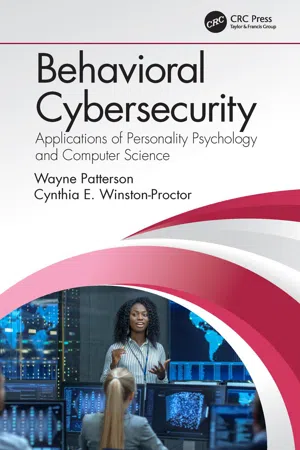
Behavioral Cybersecurity
Applications of Personality Psychology and Computer Science
- 262 pages
- English
- ePUB (mobile friendly)
- Available on iOS & Android
Behavioral Cybersecurity
Applications of Personality Psychology and Computer Science
About this book
Since the introduction and proliferation of the Internet, problems involved with maintaining cybersecurity has grown exponentially, and have evolved into many forms of exploitation.
Yet, Cybersecurity has had far too little study and research. Virtually all of the Research that has taken place in cybersecurity over many years, has been done by those with computer science, electrical engineering, and mathematics backgrounds.
However, many cybersecurity researchers have come to realize that to gain a full understanding of how to protect a cyber environment requires not only the knowledge of those researchers in computer science, engineering and mathematics, but those who have a deeper understanding of human behavior: researchers with expertise in the various branches of behavioral science, such as psychology, behavioral economics, and other aspects of brain science.
The authors, one a computer scientist and the other a psychologist, have attempted over the past several years to understand the contributions that each approach to cybersecurity problems can benefit from this integrated approach that we have tended to call "behavioral cybersecurity."
The authors believe that the research and curriculum approaches developed from this integrated approach provide a first book with this approach to cybersecurity. This book incorporates traditional technical computational and analytic approaches to cybersecurity, and also psychological and human factors approaches, as well.
Features
-
- Discusses profiling approaches and risk management
-
- Includes case studies of major cybersecurity events and "Fake News"
-
- Presents analyses of password attacks and defenses
-
- Addresses game theory, behavioral economics and their application to cybersecurity
-
- Supplies research into attacker/defender personality and motivation traits
-
- Techniques for measuring cyber attacks/defenses using crypto and stego
Frequently asked questions
- Essential is ideal for learners and professionals who enjoy exploring a wide range of subjects. Access the Essential Library with 800,000+ trusted titles and best-sellers across business, personal growth, and the humanities. Includes unlimited reading time and Standard Read Aloud voice.
- Complete: Perfect for advanced learners and researchers needing full, unrestricted access. Unlock 1.4M+ books across hundreds of subjects, including academic and specialized titles. The Complete Plan also includes advanced features like Premium Read Aloud and Research Assistant.
Please note we cannot support devices running on iOS 13 and Android 7 or earlier. Learn more about using the app.
Information
Table of contents
- Cover
- Half Title
- Title Page
- Copyright Page
- Dedication
- Contents
- Preface
- Authors
- Chapter 1: What Is Cybersecurity?
- Chapter 2: Essentials of Behavioral Science
- Chapter 3: Psychology and Cybersecurity
- Chapter 4: Recent Events
- Chapter 5: Profiling
- Chapter 6: Hack Lab 1 Social Engineering Practice: Who Am I?
- Chaprer 7: Access Control
- Chapter 8: The First Step Authorization
- Chapter 9: Hack Lab 2 Assigned Passwords in the Clear
- Chapter 10: Origins of Cryptography
- Chapter 11: Hack Lab 3 Sweeney Method
- Chapter 12: Hacker Personalities Case Studies
- Chapter 13: Game Theory
- Chapter 14: Ethical Hacking
- Chapter 15: The Psychology of Gender
- Chapter 16: Turing Tests
- Chapter 17: Personality Tests, Methods, and Assessment
- Chapter 18: Modular Arithmetic and Other Computational Methods
- Chapter 19: Modern Cryptography
- Chapter 20: Steganography
- Chapter 21: Using Cryptography and Steganography in Tandem or in Sequence
- Chapter 22: A Metric to Assess Cyberattacks
- Chapter 23: Behavioral Economics
- Chapter 24: Fake News
- Chapter 25: Potpourri
- Chapter 26: Hack Lab 4 Contradictions in Password Meters
- Chapter 27: Conclusion
- Index